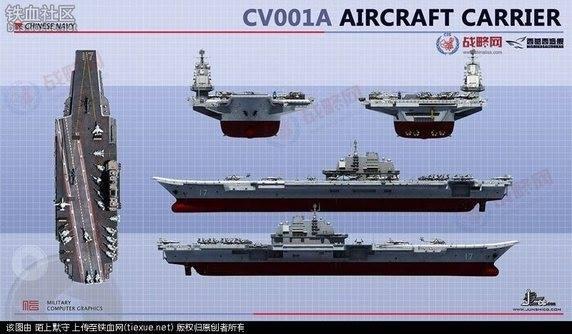The flight deck of the second Chinese aircraft carrier Type 001A is almost completed. Numerous Chinese sites (controlled by the government), the same ones that in the past have divulged photos and information on various assets in the developing world, confirm that progress is continuing at the Dalian construction site.
The 001A Type is based on the design of the Liaoning, although with some improvements and will be characterized by a STOBAR or Short Takeoff But Arrested Recovery. Although effective, the STOBAR launch is not comparable to the CATOBAR or Catapult Assisted Take Off But Arrested Recovery, take-off assisted by catapult but arrested recovery present on Nimitz US. The main difference is that a CATOBAR carrier is able to launch aircraft with more fuel and payload. To reach a level of global operations comparable to that of the US Navy, China will need decades of experience. However, it is worth noting the rapid installation of the most significant parts of the 001A vector, probably due to the Chinese modular construction process.
The second Chinese aircraft carrier will carry out the military operations typical of a carrier of its category. There Liaoning, the country's first aircraft carrier, was designed to test the reliability and compatibility of indigenous systems and staff training. It is a sort of technological demonstrator.
The second carrier will in effect be a battle platform that will contribute to the defense of national interests. It will have a displacement of 50.000 tons (ten thousand less than the Liaoning) and a conventional feeding system. It will be equipped mainly with fighters Shenyang J-15 (based largely on the Sukhoi Su-33) and the same STOBAR bridge as the class Admiral Kuznetsov. The main systems (propulsion, electronics and armament) will be implemented in China.
The Chinese are also building a third aircraft carrier in the Shanghai area: it could be equipped with nuclear propulsion. The third carrier has not yet been formalized by Beijing, although satellite photos have confirmed the start of the works. Nuclear propulsion effectively eliminates the need for refueling and extends the range of the carrier, limited only by the on-board supplies for the embarked personnel.
The only Chinese aircraft carrier, the Liaoning, entered service in the 2012. It is the second vector of the class Admiral Kuznetsov which dates back to the Soviet era. China bought the aircraft carrier from 60.000 tons from Ukraine in the 1998. It has been totally revised and modernized even though it is not yet considered fully operational (target within the 2020). The autonomy of Liaoning it is estimated in 45 days of navigation, equal to seven thousand kilometers at the maximum speed allowed, around 32 knots.












